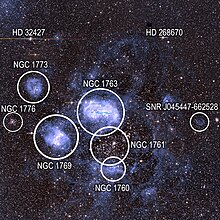|
NGC 1761
 NGC 1761 (also known as GC 980, JH 2710, LH 9)[3] is an open cluster in the Dorado constellation in the Large Magellanic Cloud. It encompasses a group of about 50 massive hot young stars. These stars are among the largest stars known anywhere in the Universe and appear as bright blue-white in colour. The stars in turn have given birth to new stars within dark globules. NGC 1761 is particularly noteworthy for its intense ultraviolet radiation, which has eroded a large hole in the surrounding nebular material. It is similar in structure to the more famous Rosette Nebula. [4][5][6] It is part of a large region of stars called LMC-N11 (N11) which was discovered with a 23-cm telescope by the astronomer James Dunlop in 1826 and was also observed by John Herschel in 1835.[3] References
External links
Information related to NGC 1761 |
||||||||||||||||||
Portal di Ensiklopedia Dunia
